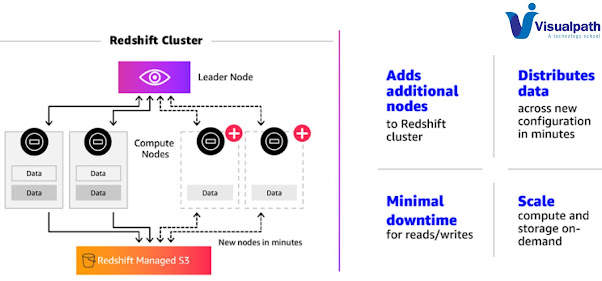Amazon Redshift: Managing clusters using the console
Managing Amazon Redshift clusters using the console involves accessing the AWS Management Console and navigating to the Redshift service. - Amazon Redshift Online Training
Here's a step-by-step guide on
how to manage Redshift clusters using the console:
1. Accessing the AWS Management Console: Log in to your AWS account at https://aws.amazon.com/ and navigate to
the AWS Management Console.
2. Navigating to Amazon Redshift: Once logged in, you can either search for "Redshift"
in the AWS services search bar or navigate to the "Analytics" section and click on "Redshift."
3. Viewing Cluster List: In the Redshift dashboard, you'll see a list of your existing
Redshift clusters. This page provides an overview of the clusters, including
their status, cluster identifier, node type, and creation time.
4. Creating a Cluster: To create a new Redshift cluster, click on the "Create cluster" button. You'll be
prompted to specify various configuration settings such as cluster identifier,
node type, number of nodes, and cluster options.
5. Modifying Cluster Configuration: If you need to modify the configuration of an existing
cluster, select the cluster from the list and click on the "Modify" button. You can then
adjust settings such as the number of nodes, node type, and additional cluster
options. - Amazon
Redshift Certification Online Training
6. Monitoring Cluster Performance: The Redshift console provides
various monitoring tools to help you track the performance of your clusters.
You can view metrics such as CPU utilization, disk space usage, and query
execution times. Additionally, you can set up automated alerts to notify you
when certain thresholds are exceeded.
7. Viewing Cluster Events: The console allows you to view a history of events for each
cluster, including cluster creation, modification, and deletion events. This can be helpful for tracking changes and
troubleshooting issues.
8. Managing Cluster Snapshots: Redshift allows you to create manual snapshots of your
clusters for backup and recovery purposes. From the console, you can initiate
snapshot creation, view a list of existing snapshots, and restore clusters from snapshots if needed.
9. Managing Cluster Security: You can manage security settings for your Redshift
clusters from the console, including configuring network access, enabling
encryption, and managing IAM roles for authentication and authorization.
10. Managing Workload Management (WLM): Redshift's workload management
feature allows you to prioritize and manage query queues to optimize cluster performance. You can
configure WLM settings from the console, including defining query queues,
setting concurrency limits, and assigning user groups to specific queues.
11. Accessing Documentation and Support: If you need help or documentation
while managing your Redshift clusters, you can access AWS documentation
directly from the console. Additionally, you can contact AWS support for
assistance with any issues or questions you may have.
By
using the AWS Management Console to manage your Amazon Redshift clusters, you
can easily create, monitor, and maintain your data warehouse infrastructure in
the cloud. - Amazon
Redshift Courses Online
Visualpath is the Leading and Best Institute for learning Redshift Training in Hyderabad. We provide Amazon Redshift Online Training, you will get the best course at an affordable cost.
Attend Free Demo Call on - +91-9989971070.
Visit Our Blog: https://amazonredshiftonlinetraining.blogspot.com/
Visit: https://www.visualpath.in/amazon-redshift-online-training.html



Comments
Post a Comment